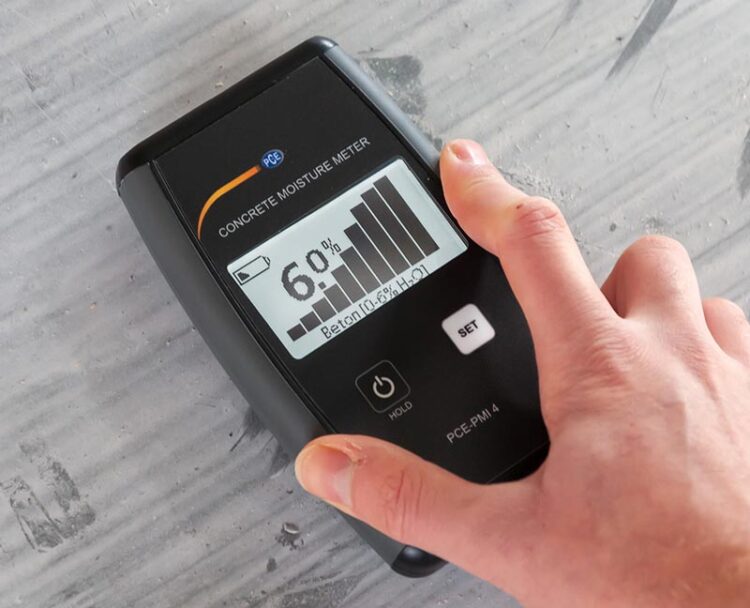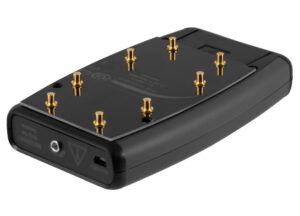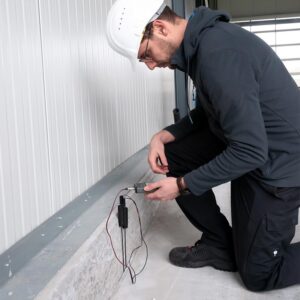The new PCE-PMI 4 – a versatile moisture meter for concrete and many other materials

Measurement with the PCE-PMI 4 on
Image: PCE Deutschland GmbH
New or subsequently soaked concrete components, screeds and plasters may only be coated with other materials when they have dried sufficiently. Otherwise, there is a risk that the coatings may flake off. The duration of the drying process depends on the level of moisture and the temperature and humidity on site. Material moisture meters which measure with electrical methods make it possible to assess the progress of the drying process quickly and easily. In the event of moisture damage, such devices can be used to immediately identify and assess the affected area.
The new moisture meter PCE-PMI 4 from PCE Instruments has special scales for the moisture of concrete and screed besides the general scale for the evaluation of the moisture difference of any material. For cement and anhydrite screeds, there is not only a scale for the moisture content in weight per cent but also separate scales showing comparative values to measurements with the calcium carbide method. In addition to the numerical value, the display shows a clear graphical representation for classification of the measured value.
The major advantages of electronic devices with capacitive measuring method are quick non-destructive measurements and easy use. However, the measuring depth and measured values are strongly dependent on the type and structure of the material to be measured and can be falsified by salts and metallic foreign bodies as well as by the operator’s hand in the measuring area. With assessable substrate materials, exclusion of disturbance variables and defined environmental conditions, reliable values are determined over several centimetres of material depth. However, the method is also suitable for the quick detection and limitation of areas with increased humidity if the underground is unknown.
The PCE-PMI 4 moisture meter with the sensor plate and the 8 spring electrodes on the back of the unit is designed for flat surfaces such as floors, walls and ceilings. To measure, power on the PCE-PMI 4, select the desired scale and place the meter on the surface to be measured. Then press the moisture meter against the substrate until all spring electrodes are completely retracted and read the measured value. The measuring process only takes a few seconds and can be repeated as often as required at the same or adjacent points.

For measurements in hard-to-reach areas, where the measured value cannot be read directly from the display, the PCE-PMI 4 offers a Max Hold mode. In this operating mode, the moisture meter does not display the currently measured value but the maximum value from all measurements in the current series of measurements. Based on the maximum value shown after the measurements, a decision can then be made as to whether detailed individual measurements are to be made again in the area under investigation.
With various optionally available needle or brush electrode pairs, the PCE-PMI 4 can measure the moisture by means of the resistance method even in places that are difficult to access. The needle electrodes cannot only be placed in narrow places but can also be pierced into wood, insulation materials or joints. The pair of electrodes with insulated 230 mm long needles allows measurements at different depths and thus the evaluation of the moisture distribution in the material cross section. When one of the optional auxiliary electrodes is connected to the PCE-PMI 4, not only the relative evaluation of moisture in digits but also scales for different types of wood with display in weight per cent are available.

Image: PCE Deutschland GmbH
The new moisture meter PCE-PMI 4 from PCE Instruments is a practical and easy-to-use device for quick moisture measurements on site. The actual field of application for flat surfaces can be extended by different additional electrodes. Thus, the device is also suitable for more detailed moisture measurements in joints, drillings, wood and insulating materials.
More information can be found here:
Media Contact
All latest news from the category: Power and Electrical Engineering
This topic covers issues related to energy generation, conversion, transportation and consumption and how the industry is addressing the challenge of energy efficiency in general.
innovations-report provides in-depth and informative reports and articles on subjects ranging from wind energy, fuel cell technology, solar energy, geothermal energy, petroleum, gas, nuclear engineering, alternative energy and energy efficiency to fusion, hydrogen and superconductor technologies.
Newest articles

Innovative 3D printed scaffolds offer new hope for bone healing
Researchers at the Institute for Bioengineering of Catalonia have developed novel 3D printed PLA-CaP scaffolds that promote blood vessel formation, ensuring better healing and regeneration of bone tissue. Bone is…

The surprising role of gut infection in Alzheimer’s disease
ASU- and Banner Alzheimer’s Institute-led study implicates link between a common virus and the disease, which travels from the gut to the brain and may be a target for antiviral…

Molecular gardening: New enzymes discovered for protein modification pruning
How deubiquitinases USP53 and USP54 cleave long polyubiquitin chains and how the former is linked to liver disease in children. Deubiquitinases (DUBs) are enzymes used by cells to trim protein…



